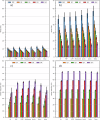Voxelwise characterization of noise for a clinical photon-counting CT scanner with a model-based iterative reconstruction algorithm
- PMID: 39747757
- PMCID: PMC11695565
- DOI: 10.1186/s41747-024-00541-2
Voxelwise characterization of noise for a clinical photon-counting CT scanner with a model-based iterative reconstruction algorithm
Abstract
Background: Photon-counting detector (PCD) technology has the potential to reduce noise in computed tomography (CT). This study aimed to carry out a voxelwise noise characterization for a clinical PCD-CT scanner with a model-based iterative reconstruction algorithm (QIR).
Methods: Forty repeated axial acquisitions (tube voltage 120 kV, tube load 200 mAs, slice thickness 0.4 mm) of a homogeneous water phantom and CTP404 module (Catphan-504) were performed. Water phantom acquisitions were also performed on a conventional energy-integrating detector (EID) scanner with a sinogram/image-based iterative reconstruction algorithm, using similar acquisition/reconstruction parameters. For smooth/sharp kernels, filtered back projection (FBP)- and iterative-reconstructed images were obtained. Noise maps, non-uniformity index (NUI) of noise maps, image noise histograms, and noise power spectrum (NPS) curves were computed.
Results: For FBP-reconstructed images of water phantom, mean noise was (smooth/sharp kernel) 11.7 HU/51.1 HU and 18.3 HU/80.1 HU for PCD-scanner and EID-scanner, respectively, with NUI values for PCD-scanner less than half those for EID-scanner. Percentage noise reduction increased with increasing iterative power, up to (smooth/sharp kernel) 57.7%/72.5% and 56.3%/70.1% for PCD-scanner and EID-scanner, respectively. For PCD-scanner, FBP- and QIR-reconstructed images featured an almost Gaussian distribution of noise values, whose shape did not appreciably vary with iterative power. Noise maps of CTP404 module showed increased NUI values with increasing iterative power, up to (smooth/sharp kernel) 15.7%/9.2%. QIR-reconstructed images showed limited low-frequency shift of NPS peak frequency.
Conclusion: PCD-CT allowed appreciably reducing image noise while improving its spatial uniformity. QIR algorithm decreases image noise without modifying its histogram distribution shape, and partly preserving noise texture.
Relevance statement: This phantom study corroborates the capability of photon-counting detector technology in appreciably reducing CT imaging noise and improving spatial uniformity of noise values, yielding a potential reduction of radiation exposure, though this needs to be assessed in more detail.
Key points: First voxelwise characterization of noise for a clinical CT scanner with photon-counting detector technology. Photon-counting detector technology has the capability to appreciably reduce CT imaging noise and improve spatial uniformity of noise values. In photon-counting CT, a model-based iterative reconstruction algorithm (QIR) allows decreasing effectively image noise. This is done without modifying noise histogram distribution shape, while limiting the low-frequency shift of noise power spectrum peak frequency.
Keywords: Algorithms; Image processing (computer-assisted); Radiation exposure; Tomography (x-ray computed); Tomography scanners (x-ray computed).
© 2024. The Author(s).
Conflict of interest statement
Declarations. Ethics approval and consent to participate: Not applicable. Consent for publication: Not applicable. Competing interests: LDM is an employee of Siemens Healthcare s.r.l. (via Vipiteno 4, 20128 Milano, Italy), but did not have control over any of the data/information submitted for publication or which data/information were to be included in this study. The remaining authors report no conflicts of interest.
Figures






References
-
- Willemink MJ, Persson M, Pourmorteza A et al (2018) Photon-counting CT: technical principles and clinical prospects. Radiology 289:293–312. 10.1148/RADIOL.2018172656 - PubMed
MeSH terms
LinkOut - more resources
Full Text Sources
Medical
Miscellaneous
